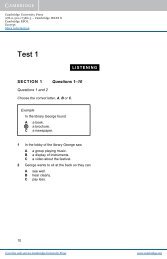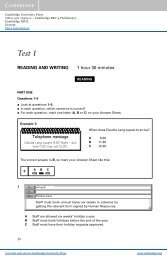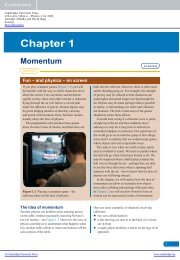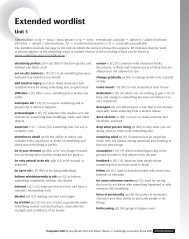Skills for Study Level 2 Teacher's Book - Cambridge University Press
Skills for Study Level 2 Teacher's Book - Cambridge University Press
Skills for Study Level 2 Teacher's Book - Cambridge University Press
You also want an ePaper? Increase the reach of your titles
YUMPU automatically turns print PDFs into web optimized ePapers that Google loves.
2 Exchanging and challenging ideas appropriately inacademic discussion2a Group discussion2bSuggested answers2.8InterruptionsBelittling other people’s contributions (e.g. “You can’t just say ‘Give them facts’.That’s meaningless.”)Rejecting other people’s suggestions out of handUsing value-laden language (e.g. Sam claims his idea is ‘intelligent’ and Leila’snaive or a no-brainer)Criticizing other ideas without suggesting how to take the discussion <strong>for</strong>ward(e.g. ‘that won’t work’).Simplistic – or even lazy – suggestions (e.g. ‘Give them facts and data’).(Also, saying things like ‘how should I know?’ can be seen as being deliberatelyunhelpful, or not trying to help take the discussion <strong>for</strong>ward.)2c Students compare their answers in groups.2d Group discussionSuggested answers‘That won’t work.’ – Criticizing other people’s ideas without suggesting how totake the discussion <strong>for</strong>ward‘That’s a complete no-brainer.’ – Using value-laden language‘Don’t be naive.’ – Using value-laden language‘You have to have a more intelligent strategy …’ – Using value-laden language‘Give them facts and data, …’ – Simplistic – or even lazy – suggestions‘You can’t just say “Give them facts”. That’s meaningless.’ – Belittling otherpeople’s contributions‘How should I know?’ – Being deliberately unhelpful, or not trying to help takethe discussion <strong>for</strong>ward3 Expressing and defending opinions3a Group discussion3b Students review the five sets of data to find evidence.Note: No suggested answers to what the data represents are given here; encouragestudents to come up with their own ideas.3c Group discussion (5–10 minutes is suggested)3d Student discussion4 Changing the direction of a discussion4aSuggested answers1 You want to change the topic completely.2 You want to go back to a topic that was considered earlier in the discussion.3 You want to move the discussion on to a different aspect of the topic.Unit 2 Part D ∙ Reporting in speech 59
















